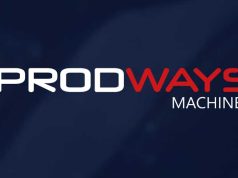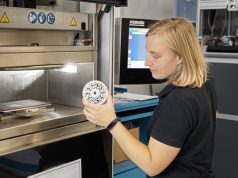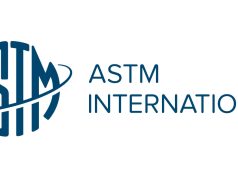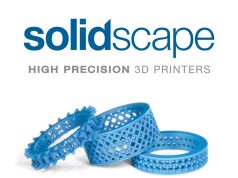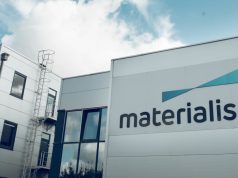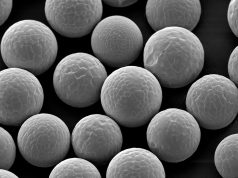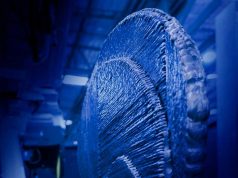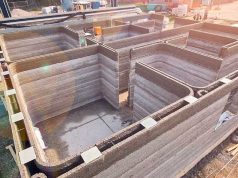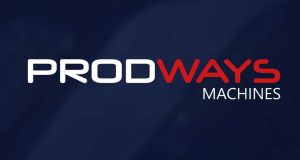Additive manufacturing makes more than just headlines. The industrial revolution of 3D metal printing is pointing the way to a change in manufacturing strategies. And facts are being established which will herald a fundamental paradigm shift for the manufacture of metal parts. AM is really pointing the way forward when it comes to substitution or as a hybrid strategy in combination with conventional machining methods.
Once again, the aerospace industry is driving forward innovation and acting as the spearhead for digital manufacturing. The most recent signal comes from Thales Alenia Space. Working in collaboration with the 3D printing service company Poly-Shape, it has produced additively manufactured parts for the new South Korean communications satellites Koreasat-5A and Koreasat-7. Koreasat-7 is set to go into orbit in 2017 at position 116º East in order to provide coverage for South Korea, the Philippines, Indonesia and India. Koreasat-5A will cater for Korea, Japan, Indochina and the Middle East from the position 113° East. Koreasat-5A should be launched before 2017 second quarter.
XXL component produced in collaborative working relationship
The Koreasat-5A and Koreasat-7 antenna supports will be the largest volume parts so far produced by powder-bed-based laser melting of metals from Europe to be in orbit. With dimensions of 447 x 204.5 x 391 mm3 – and weighing just 1.13 kg – they really can be referred to as lightweight components. A really huge piece of engineering. The additively manufactured 3D components are used as basic antenna supports for the communication with ground base of the Koreasat-5A and Koreasat-7 satellites. An identical part was installed in both satellites. The dimensions presented a real challenge for Thales Alenia Space. They were manufactured by the French company Poly-Shape. It is a renowned partner to the aerospace industry when it comes to prototyping, 3D metal printing and assemblies.
Lightweight construction and reduction in costs as crucial advantages
Aluminum (Al) is the metallic material most commonly used for satellites due to its weight and thermal conductivity. The less weight that needs to be put into orbit, the better. Florence Montredon, Head of AM at Thales Alenia Space, says: “As a rule of thumb, the actual costs of putting 1 kg into orbit are around EUR 20,000. So every gram really does count. The starting weight of the two new satellites is around 3,500 kg.” AM’s potential for lightweight design was therefore a key reason to move away from the traditional methods. For these AM parts Thales Alenia Space chose an AISi7Mg alloy. Applications in space demand high strength, rigidity and resistance to corrosion from the materials that are used. The component validation process also revealed a low porosity rate on the finished

component of < 1%. The tests of tensile and shear strengths also produced pleasing results. For example, the tests in relation to symptoms of fatigue according to Wöhler yielded values that significantly exceeded the required specifications. Minor deviations in the geometry were corrected with simple reworking, as was a small crack which was revealed by the CT. Fairly small pores inside the geometry were accepted following localized mechanical analysis. Ultimately, the parts successfully passed the dynamic tests carried out at Thales. Florence Montredon: “The effects were huge: A 22% weight saving for the bionic AM structure compared to a conventional structure. Not forgetting a reduction in costs of around 30% with the finished part being available very much faster.” The cost reduction of 30% is attributable to various factors. First there is the reduction in outlay on assembly: The redesign as an additive, bionic part replaced the number of parts that were previously produced from nine to one. And this was done through one-shot manufacturing, without the previous outlay on assembly. Secondly there was no need for mold construction, as casting would have needed to make the same part. Thirdly the temporal aspects are interesting when it comes to completing the ambitious stages of a project such as this on time. This is known in industry as time to market. In this sector, it is referred to as time to fly.
Machine and plant technology from Concept Laser on XXL scale
Poly-Shape has 28 3D metal printing machines which have different sizes of build envelope. The largest build envelope dimension for 3D printing with aluminum at Poly-Shape is currently an X line 1000R from Concept Laser. It offers a build envelope of 630 x 400 x 500 mm3 and has a closed system for reliable process and powder management in accordance with the ATEX directives. The X line 1000R also has a rotating mechanism which allows two build modules to be used reciprocally, thus guaranteeing constant production with no downtimes. This unique machine design not only results in greater availability, but also simple and above all secure handling when arming and disarming the machine. The follow-up model, the X line 2000R, has an even bigger build envelope (800 x 400 x 500 mm3), which is currently unique in the world when it comes to powder-bed-based laser melting. The usable build volume is again increased, in comparison to an X line 1000R, by around 27% from 126 l to 160 l. The follow-up model also operates with two lasers, each delivering 1,000 watts of power. The LaserCUSING process technology from Concept Laser was very important for the project: What makes systems from Concept Laser unique is stochastic navigation of the slice segments (also referred to as “islands”) which are processed successively. This patented process ensures a significant reduction in stresses when manufacturing very large parts. With huge dimensions of 447 x 204.5 x 391 mm3, it is obvious to want to control warping to the maximum extent possible. The X line 1000R offers balanced temperature regulation of the build envelope in order to prevent warping in the “oversized” parts. The large, bionic and intricate geometry takes a great deal of time to assemble: It took only a few days to print it.
Design to suit the process
The transition over to AM also means rethinking the design. To make full use of the potential offered by laser melting, it makes no sense to replicate a geometry 1:1. Lightweight design and bionics demand a design to suit the process. CAE-CAD-based methods are used to trim the 3D components to a performance-focused geometry, bionics, and lightweight design. The design was optimized in several transitions at Thales Alenia Space (AM design optimization), for example in respect of the various joining and mounting techniques. In addition, there was fine-tuning in the area surrounding the satellite in order to guarantee a maximum precision fit. The topology was optimized in 2-3 passages. The CAD data then underwent a redesign and smoothing before a mechanical analysis and simulation took place. Furthermore, the design was optimized to suit the process-related circumstances in the build envelope with Poly-Shape. This involved the orientation of the part in the build envelope and the necessary support structures. Thales Alenia Space also incorporated methods of LBM (Layer-Based Manufacturing). Florence Montredon: “It is clear that we have identified AM as a good prospect for further projects. In the future, we would also like to incorporate thermal control technology or radio functions directly on or within the 3D structures. So functional integration is the next task. This is also a logical consequence of the potential offered by AM.”
Verdict
In the Koreasat-5A and 7 project, the feasibility of highly sophisticated and very large AM parts for applications in space was highlighted. The redesign as an additive, bionic part made it possible to reduce the number of parts from nine to just one part. Thanks to this method, the manufacturing process was carried out in one shot, so without the previous outlay that was needed for assembly. There was also significantly enhanced potential for a lightweight design. 22% of the mass was saved with this AM solution. This resulted in a final weight of just 1.13 kg. This was a huge leap because in these applications every gram really does count. The 3D geometry was optimally trimmed for use in orbit. The project’s impressive results highlighted the potential that additive manufacturing offers in space travel and this project will undoubtedly not be the last of this type.
Interview with Thales Alenia Space and Poly-Shape on the Koreasat-5A and Koreasat-7 project
Which techniques and manufacturing methods do you use to manufacture your products?
Florence Montredon: Given the very low quantity of individual components for satellites and the small number of satellites in general, 3D printing is an ideal option for manufacturing. By comparison, cast parts, that is to say mold-based processes, tend to be more suitable for components that need to be manufactured in larger batches.
Please outline the Koreasat -5A and 7 project in brief.
Florence Montredon: By manufacturing the Koreasat-5A and Koreasat-7 telecoms satellites, we wanted to demonstrate that the laser melting technology opens up numerous possibilities for our applications. The essential benefits are the short timeline from design and development through to the finished part. Also the high level of efficiency. Ahead of our project, a first AM part was initially manufactured from aluminum. This part was successfully approved in 2014 and used for the Turkmenalem Monacosat in April 2015. The two new parts for the satellite are used as basic antenna supports for communication with the ground base. They are also made of aluminum. They were manufactured by the French company Poly-Shape. The first challenge was that we needed two identical parts: They are twins – one for Koreasat-5A and the other twin for Koreasat-7. But the principal challenge was the size. In comparison to our previous references and experiences, the dimensions of the parts were huge.
Please describe the parts to us in brief.
Florence Montredon: Aluminum is the metallic material most commonly used for satellites – due to its weight and thermal conductivity. For these AM parts we chose an AISi7Mg alloy. This standard material has already been validated in casting technology for space applications. The redesign as an additive, bionic part made it possible to reduce the number of parts from nine to just one part. In one shot, so without the previous outlay that was needed for assembly. There was also significantly enhanced potential for a lightweight design. We saved 22% of the mass, which resulted in a final weight of just 1.13 kg. This was a huge leap because in our applications every gram really does count.
Stéphane Abed: The dimensions are 447 x 204.5 x 391 mm3. A huge dimension. It took around six days to print them. It is the largest AM part destined for orbit that has so far been produced in Europe.
What were the particular challenges of building the biggest 3D metal part?
Stéphane Abed: Examples of the issues involved were feasibility, the tendency to warp, geometry and the weight. Using CAE/CAD tools for optimization, the Thales Alenia Space designers managed to optimize the design, that is to say the geometry, to suit the process and at the same time save weight and meet the load requirements. The Thales Alenia Space designers did a very good job. The final design was then optimized and fine-tuned in numerous redesign stages with close collaboration and interaction between Thales Alenia Space and Poly-Shape when it came to fabrication. What we have here is a bionically optimized design.
Florence Montredon: The antennas supports then underwent both specific elementary on ground tests. They will also be submitted to usual testing at satellite level: this includes a vibration test and high temperatures in a vacuum in order to test a required lifespan of 15 years in orbit.
How did you embark on laser melting?
Florence Montredon: Laser melting is a very promising process for satellite applications. It is perfectly suited to small numbers of units, opens up plenty of scope for lightweight design and is an ideal option for very complex geometries.
What experience did you gain in the project with laser melting in comparison to the previous manufacturing strategies?
Florence Montredon: The powder-bed-based laser melting technology is ideally suited to optimizing the design and makes it possible to achieve a significant weight saving. And weight reduction is one of the most important objectives for us. As a rule of thumb, the actual costs of putting 1 kg into orbit are around EUR 20,000. Space law also encourages us to reduce the quantity of metallic materials in flying objects because they present an emissions hazard when the satellite re-enters the atmosphere. So it is all about lightweight design, sustainability and helping to protect the environment. We do of course also expect these technologies to reduce costs and deliver benefits in the tight schedule for space missions. In the project, we identified a cost-savings potential of around 30% compared to the previous conventional solution with assembly.
How did the collaboration between Thales Alenia Space and Poly-Shape come about?
Florence Montredon: We met the team from Poly-Shape SAS in 2010 at a joint French R&D project. It quickly became clear to us that the team from Poly-Shape would become a strategic partner for our AM developments. We worked together very successfully and above all quickly to develop the first aluminum parts. It was therefore of course obvious that we would want to work with them again on this new challenge.
Why did you choose to use machines from Concept Laser?
Stéphane Abed: Concept Laser was a particularly attractive option here because these machines are the only ones that offer the build envelopes required for 3D metal printing. There are currently no other alternatives, unless you use smaller build envelopes and then join the parts together. This carries the risk of weak points in the structure. One theoretical alternative would have been to print the parts in two halves and join them together, but we would have lost the benefit of the reduction in the amount of assembly work that is possible here. In addition, the joining process may have revealed possible defects which can be ruled out with the one-shot option of laser melting. Not forgetting – with one part we can achieve our objective faster.
Which machines did you employ at Poly-Shape for the 3D metal printing?
Stéphane Abed: Poly-Shape has 28 3D metal printing machines which have different sizes of build envelope. This allows us to cater for almost any dimensions that customers want. In principle, we focus on rapid prototyping and small batches. The largest build envelope dimension for 3D printing with aluminum at Poly-Shape is currently an X line 1000R from Concept Laser. The technology used there is known as LaserCUSING. The LaserCUSING process technology was very important: What makes systems from Concept Laser unique is stochastic navigation of the slice segments (also referred to as “islands”) which are processed successively. This patented process ensures a significant reduction in stresses when manufacturing very large components, as in this case. The X line 1000R offers balanced temperature regulation of the build envelope in order to prevent warping in the “oversized” components. In addition, on this machine we are able to create not just aluminum parts, as are customary in satellites, but also process reactive materials such as titanium or titanium alloys, or also nickel-base alloys. These groups of materials are vital in aircraft construction. Concept Laser now also offers an X line 2000R with multilaser technology. This might be an interesting option for us due to the increased build rate and an even larger build envelope (800 x 400 x 500 mm3). The latest technology is hugely important to us: In 2015 alone, we invested around 2.5 million EUR in plant technology and tools, as well as around 1 million EUR in research & development.
What new experiences were you able to gain in the project?
Stéphane Abed: 3D metal printing necessarily requires a design that suits the process so that the advantages of a digital approach can be exploited in full. In terms of the freedom of geometry, the advantages are huge and incomparable to anything offered by conventional manufacturing technologies. Digital parts look different, do more, and tend to be lighter. In certain batch size ranges, by which I mean small and medium-sized batches, they are often the better alternative from an economic perspective. But the limits shift upward every year, and this opens up more and more new horizons for AM. Assignments for Thales Alenia Space do of course present particular challenges for the whole team. But there is also the benefit of building up a great deal of know-how in design, development and process configuration. This does of course also apply to our other customers in the aerospace sector. I always say: Aerospace provides good training and practice to be right at the forefront with additive strategies.
Florence Montredon: To deliver such quality for the demanding applications in space travel, there does of course also need to be a strong partnership between the end user and the manufacturer. You need to be able to rely on your partner. A close working relationship and mutual interaction between Thales Alenia Space and Poly-Shape was essential, also for meeting the ambitious timetables. Teamwork and communication are very important.
Did functional integration play a role in the project or not? How do you see this in the future?
Stéphane Abed: The 3D aluminum part replaced nine parts from the previous design. The old design was an arrangement of 2 sandwich honeycomb panels with metal inserts and milled webs which were screwed and stuck together. We have now been able to produce this structure in one shot in a single component without any need for assembly.
Florence Montredon: It is clear that we have identified AM as a good prospect for further projects. Lightweight design, unlimited geometric freedom, functional integration as well as time and cost benefits clearly favor this technology. The Arabsat 6B satellite, which was launched into orbit in November 2015 in French Guiana, has 3D parts on board. But our experiences will take us still further. In the future, we would also like to integrate thermal control technology or radio functions directly on or within the 3D structures. So functional integration is the next task. This is also a logical consequence of the potential offered by AM.
What do you think about when it comes to “materials”?
Florence Montredon: New materials with AM are of course an area of great interest. Specific powder alloys will probably be developed and validated in the future in order to meet greater requirements in the areas of lightweight design, functional integration or loading. For applications in space, we generally require high strength, rigidity and resistance to corrosion from the materials that are used. In particular to cater for the stability requirements of scientific and observation satellites, the materials should display very low thermal expansion.
Let’s now examine the prospects for powder-bed-based laser melting of metals. What trends do you see impacting on the aerospace sector in the medium and long term as a result of AM technology?
Florence Montredon: I believe that 3D metal printing will enable new products to be manufactured, based on a very integrated functional approach. The size of the parts and the build rates will probably also increase. This does of course present a real challenge for machinery and plant manufacturers. I also believe that in the future technologies will need to be combined to a greater extent in order to derive the maximum benefit for the end product. This is an idea for hybrid parts or hybrid processing, that is to say AM and milling, AM and joining technology or the assembly of AM parts and lasered profiles. In every conceivable case, laser technology will have an important role to play. The new possibilities will shape future manufacturing. Conventional technologies will be complemented by new technologies. They will grow together and will be partly substituted, as in our case. The future is bright and offers a range of answers. The digital process chain of 3D printing will set new standards. For new products with properties that exceed today’s solutions and for new manufacturing concepts that save weight, time and money.
What do you expect from the machinery and plant manufacturers?
Stéphane Abed: A young technology such as laser melting offers great opportunities, but also risks. This applies equally to the machine manufacturers and to us as users. The rapid pace of technical progress demands constant investments in the latest technology to improve the added value. In the case of 3D printing, the drives for innovation are comparable to those in the computer industry. As a daily and now long-standing user of the technology, Poly-Shape will require more quality management and greater productivity in the manufacturing process in the future. The parts that we produce are parts that have extremely sophisticated functions, are exposed to high loads and sometimes are very sensitive. This requires an extremely high level of quality to meet the ambitious requirements. Quality management can be carried out during the actual manufacturing process with the latest machines available on the market. For example, Concept Laser offers QM Meltpool 3D as a tool for this. There is thus no need for destructive and expensive tests which were previously commonplace. The second point relates to the build rates from an economic point of view. One answer here is to embrace multilaser technology and further efforts on the part of the machinery and plant manufacturers.
We thank you for the interview.
Subscribe to our Newsletter
3DPresso is a weekly newsletter that links to the most exciting global stories from the 3D printing and additive manufacturing industry.










